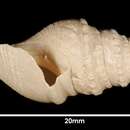en
names in breadcrumbs


“Micantapex parengonius n.sp. Fig. 168.
1881. Pleurotoma (Genota) engonia Watson, Journ. Linn. Soc. London, vol. 15, p. 405 (in part).
1886. Pleurotoma (Genota) engonia Watson, Chall. Rept., vol. 15, p. 300 (in part). 1942. Micantapex sp. Powell, Bull. Auck. Inst. Mus., 2, p. 56.
Powell (1942, p. 56) has shown that the Japanese Station (Challenger Station 232) is undoubtedly the type locality for Watson's engonia and that the “very rubbed" New Zealand specimen from Station 169 was only tentatively included in engonia by Watson. The Chatham Island Expedition obtained numbers of specimens of a large Micantapex from depths ranging from 220 to 330 fathoms. This is very close to engonia Watson, though separable. These specimens differ from Watson's figure of engonia in having a strong subsutural fold with well-marked fine axials and a nodulous primary keel on the spire whorls (27 nodules on the antepenultimate). There are some 35 to 40 smooth cords on the body whorl, four forming the keel and ten on the shoulder and subsutural fold, those on the shoulder considerably weaker.
Height, 34.7 mm.; diameter 14.3 mm. (holotype).
Holotype (M. 9786) and paratypes in Dominion Museum; paratypes in Canterbury Museum.
Localities: C.I.E. Station 52, Chatham Rise, in 260 fathoms (type); C.I.E. Stations 6, 7, 58, and 59, Chatham Rise, in 220, 280, 320, and 290 fathoms respectively; C.I.E. Station 41, south-east of Pitt Island, in 330 fathoms.
The radula (fig. 257) is highly reduced, consisting of loosely connected, paired teeth. Teeth lanceolate and narrow with an expanded three-angled base. Kuroda and Habe (1952) list engonia Watson tentatively under Suavodrillia Dall, 1918, type species Drillia kennicotti Dall, Recent, Alaska. Powell (1942) has included Suavodrillia in the subfamily Cochlespirinae while Micantapex is included in the subfamily Turrinae. The radular characters for the latter subfamily are given as "wish-bone" shaped, a character that would exclude Micantapex from this subfamily. The teeth are in keeping with the radulae shown for the subfamily Clavinae. So little is known of the dentition of the Turrid genera, however, that little point can be served by attempts to readjust the higher classification in the group until more adequate data are available.”
(Dell, 1956: 129-130)